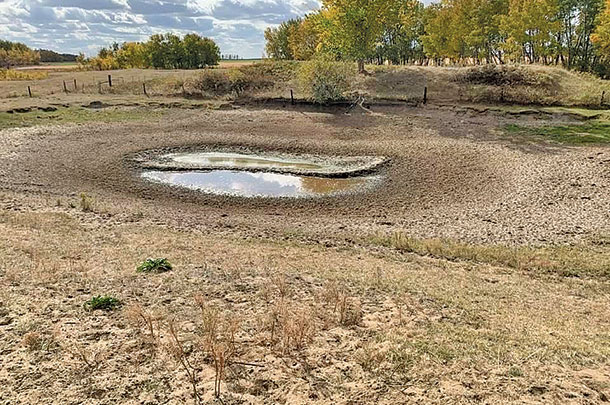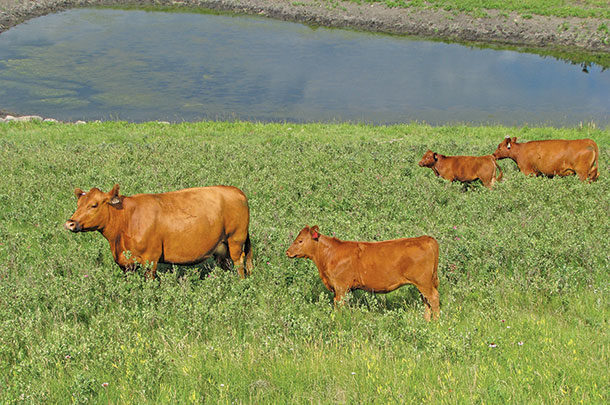Access to good-quality water is one of the limiting factors in most grazing systems. During drought, this becomes an even greater challenge as water sources become low, creating water shortage and potential for toxicity. Providing adequate, safe water to livestock is critical for animal health and production. A 10% loss of body water is fatal to most species of domestic livestock. Water accounts for more than 98% of all molecules in the body and between 50% and 81% of an animal’s total bodyweight at maturity.
The amount of water livestock need depends on the type of animal and stage of production, with requirements often doubling during hot weather. The general estimates of daily water intake for beef cattle when the temperature is 90ºF are:
- Cows – 18 gallons for nursing calves, 15.3 gallons for bred dry cows and heifers
- Bulls – 20 gallons
- Growing cattle – 9.5 gallons for a 400-pound animal, 12.7 gallons for a 600-pound animal, 15 gallons for an 800-pound animal
- Finishing cattle – 14.3 gallons for a 600-pound animal, 17.4 gallons for an 800-pound animal, 20.6 gallons for a 1,000-pound animal, 24 gallons for a 1,200-pound animal
The quality of water impacts cattle intake and weight gain. Studies have reported improved gains by as much as 0.24 pound per day in yearlings and 0.33 pound per day in calves drinking good-quality water.
When surface waters become low, the mineral components of the water become more concentrated, as they do not evaporate with the water. Of particular concern are increased concentrations of total dissolved solids (TDS) and sulfates, which can be toxic to livestock. For most classes of grazing livestock, the TDS in the water should be less than 5,000 parts per million (ppm).
 When runoff is low in the spring or during a drought, the salts in surface water become more concentrated as water levels decline and can reach levels that can be toxic. Photo courtesy of Miranda Meehan.
When runoff is low in the spring or during a drought, the salts in surface water become more concentrated as water levels decline and can reach levels that can be toxic. Photo courtesy of Miranda Meehan.Sulfate is part of the TDS. The recommended concentration should be less than 500 ppm for calves and less than 1,000 ppm for adult cattle. High levels of sulfate can reduce copper availability in the diet. Elevated levels of sulfates may cause loose stool, whereas very high levels of sulfate can induce central nervous system problems.
Ranchers should monitor TDS and sulfate levels throughout the grazing season, as weather and other factors can influence water quality. We recommend the use of handheld TDS meters as a quick method to screen water samples. If the screening indicates the TDS is greater than 4,500 ppm, submit a sample to a lab for additional analysis. Sulfate test strips are another tool available to screen water samples. Both these tools are affordable and easy to use.
Drought increases the risk for cyanobacteria (blue-green algae) blooms that can produce toxins harmful to livestock, wildlife and people. Toxicity is dependent on the species consuming the water, the concentration of the toxin or toxins and the amount of water ingested.
Cyanobacteria can produce neuro- and liver toxins. Signs of neurotoxin poisoning can appear within five minutes to up to several hours after ingestion. In animals, symptoms include weakness, staggering, muscle tremors, difficulty in breathing, convulsions and, ultimately, death.
The best method for monitoring cyanobacteria is visually; unfortunately, this can be difficult due to how rapidly a bloom can develop and ranchers’ ability to check water frequently. One potential solution is the use of a camera to monitor water locations.
If a bloom is observed, livestock should be removed immediately and a sample should be submitted for additional testing. The sample can be evaluated microscopically for potentially toxic species of cyanobacteria, or the water can be analyzed for several of the toxins at commercial labs at a higher cost.
As you develop your drought plan, it is critical to include strategies to ensure livestock have adequate, good-quality water. Short-term solutions include hauling water, using temporary pipelines or portable tanks. Make sure adequate tank storage is available, clean equipment for hauling water and a reliable water source. While these are short-term fixes, they can get you through a drought.
Consider installing water developments to increase your drought resilience in the long term. Water developments are one investment that give producers the most bang for the buck. Common water developments include troughs, pumps, wells and pipelines.
Many cost-share opportunities are available to producers for installing water developments and include Farm Service Agency, Natural Resources Conservation Service, Soil Conservation District and conservation groups. In addition, the North Dakota State Water Commission has opened the Drought Disaster Livestock Water Supply Program, which will cover up to $3,500 of the eligible costs for water development projects.
When thinking about water developments, also consider the importance of maintaining an ample supply of good-quality water for cattle during the heat of the summer. Heat stress can have major impacts on cattle productivity and can be life-threatening. Evaluate your water supply lines and ensure you have sufficient water pressure and flow capacity to keep troughs full during times of peak water consumption.
Improving livestock’s access to good-quality water not only increases drought resilience, but can expand your grazing options. Water developments in spring and summer can improve grazing distribution as livestock tend to congregate near water sources. Distribution and utilization can be further improved by cross-fencing to create additional pastures in a grazing system. Installing livestock watering sources in cropping systems allows you to utilize crop residues and cover crops for forage. Over time, these improvements, combined with appropriate management, have the potential to increase the carrying capacity of your operation, allowing for an increase in herd size or increased drought resilience with stockpiled forages.









